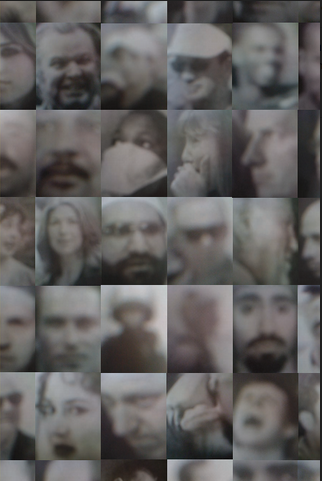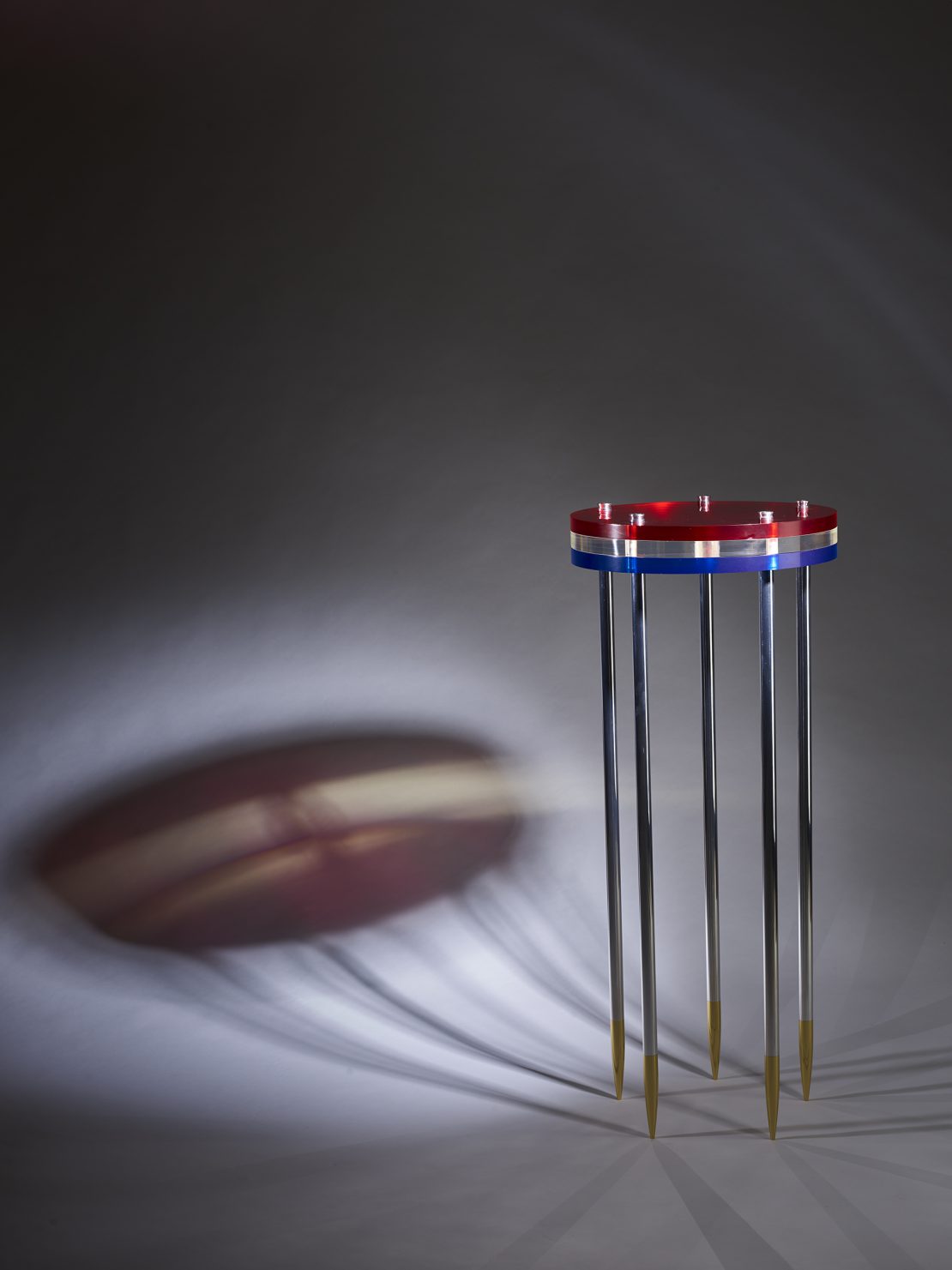By Grant Rindner
The air of protest is undeniable in Rick Valicenti’s newly opened (maybe) This Time exhibit at Loyola University’s Ralph Arnold Fine Arts Annex, on view through Nov. 26. But the veteran graphic designer and current Loyola Artist in Residence uses his collection to do much more than revisit the same statistics and imagery that we constantly see associated with contemporary issues such as gun violence. His works on exhibit are both subtly transformative and viscerally biting. They include everything from a red, white and blue table with dangerously pointed legs to a collection of blurry portraits pulled from the background figures in New York Times photos.
“I have purposely no responses to gun violence in the exhibit. The exhibit is a handful of issues that are in the environment we live in, this polarized messy environment,” Valicenti says. “As a designer, not a politician, not an activist, I wanted to respond to them and give the students an example of how to move their responses to these issues to a place that transcends the normal world of graphic design intervention, i.e. infographics, public service announcements, protest posters.”
To accomplish this, Valicenti created more than a dozen pieces in a variety of media, ranging from 3D prints to polyurethane resin to found objects that encompass a variety of reactions including sarcasm, frustration, and detachment. He wanted to explore an alternative to the traditional methods of graphic design activism and dedicated the exhibit to the Loyola students who he will be working with on capstone projects related to gun violence in the coming year.
He throws traditional interpretations of violence aside. “Those vehicles for expression, while they are completely valuable, I would argue that the public who comes in contact with them – and we all come in contact with them every day if we swipe our phones, read a newspaper, watch any cable television news network – are numb to those interventions,” Valicenti says.
Chicagoans are well acquainted with this grim reality as it pertains to the city’s recent uptick in shootings. A Chicago Tribune piece posted Monday noted that at least 3,475 people had been shot in the city this year, up by more than 1,000 in the same time frame from 2015. Another Tribune story reported that August 2016 was the city’s most violent month in nearly 20 years, per data from the Chicago Police Department.
While the connection between some of Valicenti’s pieces and the social justice theme is more elusive, others are highly effective at making the audience consider the course of society today. “You,” a craggily piece of typography, is a literal representation of the numbing effect Valicenti mentions. The word “You” is presented as a harsh gray form in two images, one with a white background and one on black. The piece’s subtitle, “Hardened Over Time,” drives home the feeling of desensitization.

Both “Monument Maquette” and “Flacid Force” are inspired by the iconic photos of a lone man standing in front of a line of tanks during the Tiananmen Square protest in 1989. In the former, Valicenti crafted 3D figures of the man and the tank, while in the latter he recasts the image five times in different neon colors, substituting the anonymous protestor for an adult woman, a small child, and a poodle, among others.
“There’s lots of speaking truth to power with just your presence – perhaps it was my time in Beijing and in Tiananmen Square. I thought that was such an extreme relationship just between material, the brute force of a tank made of steel and the vulnerable flesh of a human, says Valicenti, who spent time working with the Beijing Institute of Fashion Technology from late 2013 to early 2014.
Nicole Ferentz, a professor in the Department of Fine and Performing Arts who has a professional graphic design background and teaches visual communication, is a major reason Valicenti wound up with the Loyola residency. The two knew and respected each other and Ferentz was inspired to apply for the grant needed to bring him to the university after he left a lasting positive impression on her students.
“Rick is a really inspiring creative voice, graphic designer, and artist within the community. I’d had him come as a guest in a class or two and in one class over the whole next couple weeks students came to me to thank me for bringing him,” Ferentz says. “He’s creating a climate for young designers where they’re encouraged to make statements of their own.”

Valicenti founded Chicago communication design firm Thirst and was honored with a Smithsonian Cooper Hewitt Communication Design award in 2011,
Despite the myriad of powerful pieces in the gallery, one of the most thought-provoking works Valicenti made for it is actually outside the exhibit space. “Backgrounded” is a collection of black-and-white portraits culled from the background of New York Times news stories, and the collage actually adorns the outside wall of the Ralph Arnold Gallery so that it is visible to passersby.
“There’s always more to the story than what the camera focuses on, there’s more to the moment than just that flash of the shutter,” Valicenti says of the piece. “So I thought as I looked at pictures, there’s something very interesting about what’s going on in the back.”
For those fatigued by the media’s portrayal of ongoing crises, (maybe) This Time’s diverse, cerebral approach is an antidote likely to elicit a powerful response from a community all too familiar with these kinds of issues. Hopefully, it will also lead the next generation of graphic designers to think about social issues more creatively.
“Is there a way that the designer can create something more compelling or inviting or catalytic, so that the conversation can be re-inspired and maybe started all over again?” Valicenti asks.
(maybe) This Time is on display at the Ralph Arnold Fine Arts Annex from 12:00 p.m. to 4:00 p.m. on Saturdays through Nov. 26 to the public and 8:00 a.m. to 10:00 p.m. daily with a Loyola ID.


